英语说课稿_ppt
- 格式:ppt
- 大小:543.50 KB
- 文档页数:22
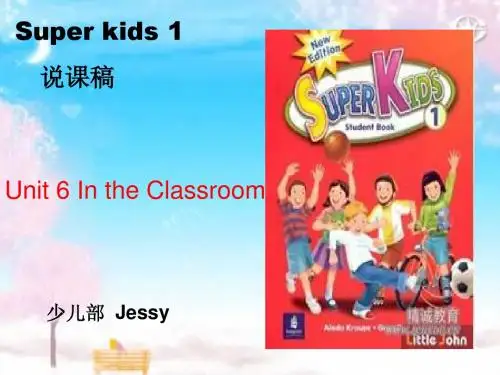
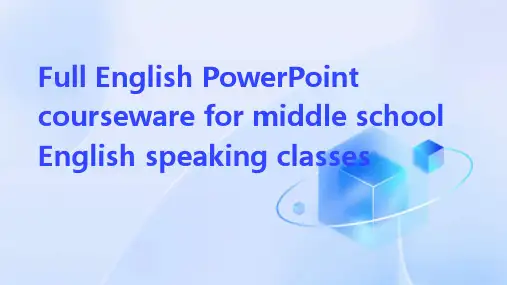
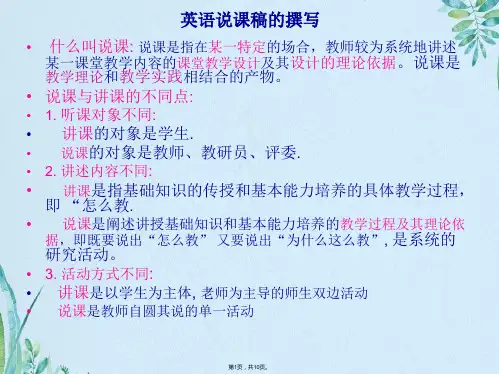
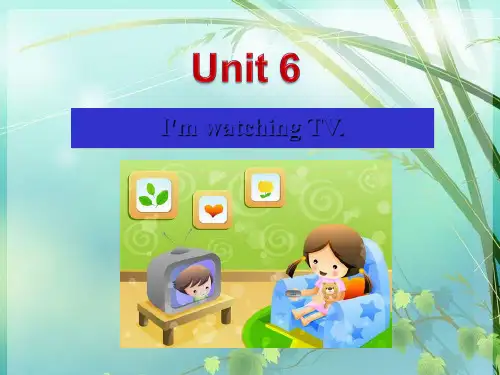
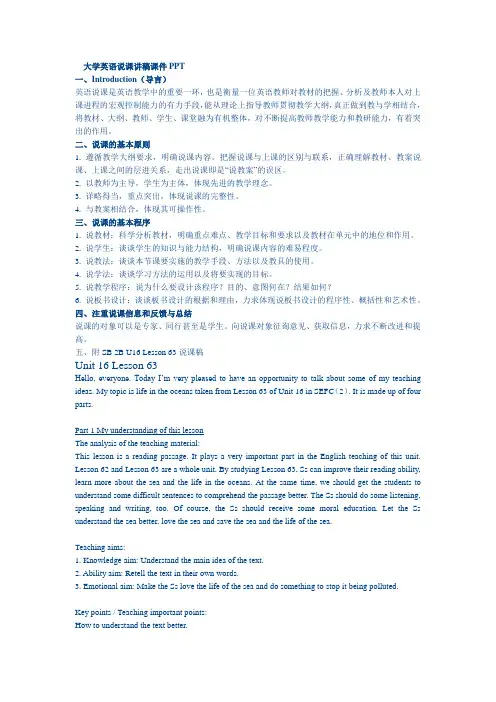
大学英语说课讲稿课件PPT一、Introduction(导言)英语说课是英语教学中的重要一环,也是衡量一位英语教师对教材的把握、分析及教师本人对上课进程的宏观控制能力的有力手段,能从理论上指导教师贯彻教学大纲,真正做到教与学相结合,将教材、大纲、教师、学生、课堂融为有机整体,对不断提高教师教学能力和教研能力,有着突出的作用。
二、说课的基本原则1. 遵循教学大纲要求,明确说课内容。
把握说课与上课的区别与联系,正确理解教材、教案说课、上课之间的层进关系,走出说课即是“说教案”的误区。
2. 以教师为主导,学生为主体,体现先进的教学理念。
3. 详略得当,重点突出,体现说课的完整性。
4. 与教案相结合,体现其可操作性。
三、说课的基本程序1. 说教材:科学分析教材,明确重点难点、教学目标和要求以及教材在单元中的地位和作用。
2. 说学生:谈谈学生的知识与能力结构,明确说课内容的难易程度。
3. 说教法:谈谈本节课要实施的教学手段、方法以及教具的使用。
4. 说学法:谈谈学习方法的运用以及将要实现的目标。
5. 说教学程序:说为什么要设计该程序?目的、意图何在?结果如何?6. 说板书设计:谈谈板书设计的根据和理由,力求体现说板书设计的程序性、概括性和艺术性。
四、注重说课信息和反馈与总结说课的对象可以是专家、同行甚至是学生。
向说课对象征询意见、获取信息,力求不断改进和提高。
五、附SB 2B U16 Lesson 63说课稿Unit 16 Lesson 63Hello, everyone. Today I’m very pleased to hav e an opportunity to talk about some of my teaching ideas. My topic is life in the oceans taken from Lesson 63 of Unit 16 in SEFC(2). It is made up of four parts.Part 1 My understanding of this lessonThe analysis of the teaching material:This lesson is a reading passage. It plays a very important part in the English teaching of this unit. Lesson 62 and Lesson 63 are a whole unit. By studying Lesson 63, Ss can improve their reading ability, learn more about the sea and the life in the oceans. At the same time, we should get the students to understand some difficult sentences to comprehend the passage better. The Ss should do some listening, speaking and writing, too. Of course, the Ss should receive some moral education. Let the Ss understand the sea better, love the sea and save the sea and the life of the sea.Teaching aims:1. Knowledge aim: Understand the main idea of the text.2. Ability aim: Retell the text in their own words.3. Emotional aim: Make the Ss love the life of the sea and do something to stop it being polluted.Key points / Teaching important points:How to understand the text better.Teaching difficult points:1. Use your own words to retell the text.2. Discuss the pollution of the sea and how to save the sea.Something about the Ss:1. The Ss have known something about the sea and sea life through the Internet and other ways.2. They are lack of vocabulary.3. They don’t often use English to express themselves and communicate with others.4. Some Ss are not active in the class because they are afraid of making mistakes.Part 2 My teaching theories, methods and aidsBefore dealing with this lesson, I’ll do my best to carry out the following theories: Make the Ss the real masters in class while the teacher himself acts as director;Combine the language structures with the language functions; Let the students receive some moral education while they are learning the English language.Teaching method:Double activities teaching methodQuestion-and-answer activity teaching methodWatch-and-listen activityFree discussion methodPair work or individual work methodTeaching aids:1. a projector2. a tape recorder3. multimedia4. the blackboardPart 3. Teaching steps / proceduresI have designed the following steps to train their ability of listening, speaking, reading and writing, especially reading ability.The entire steps are:Greetings, Revision, Lead-in and preparation for reading, Fast reading(scanning), Listening, Intensive reading, Preparation for details of the text, Consolidation, Discussion, HomeworkStep 1 GreetingsGreet the whole class as usual.Step 2. Revision1. Ask students some questions to revise the last lesson(show them on the screen).a. How much salt do the oceans contain per thousand parts of water?(35 parts of salt. 3.5% by weight)b. What is coral? Why are corals not found in deep water?c. Why is the Dead Sea called the Dead Sea?2. Check the homework(made a survey about the sea or sea life by surfing the Internet or asking for help from other people). Through this part we can consolidate what they studied yesterday, communicate with others about their survery results and prepare for the new lesson.Step 3. Lead-in and preparation for readingShow them some pictures and let them talk each other, and then use the pictures about sea and life in the oceans to learn new words, for example, Antarctica, huge whale, sperm whale, squid and so on. Purpose: Arouse the students’ intere st of study.Bring in new subject: Life in the oceans.Step 4. Fast readingRead the passage as quickly as they can. I show the questions on the screen and let them get the main idea of each paragraph:1. Why can living things live in such oceans around the Antarctica?2. What does the whale feed on?3. What is the difference between the sperm whale and other whales?Method: Read the text individually, use question—and—answer activity.Purpose: Improve the students’ reading ability.Understand the general idea of each paragraph.Step 5. Listening(book closed)1. Listen to the tape then do an exercise(wb page 90, part 1)2. True or false exercise.(on the screen)Train the Ss’ listening ability and prepare for later exercises.Step 6. Intensive readingRead the passage carefully again and answer some detailed questions on the screen.1. How much does a whale eat at a time?2. Do all the whales feed on small fish?3. How deep can a sperm whale dive?It is also called depth reading or study reading. It means reading for detailed information.Purpose: Further understand the text (Train further reading ability)to find out some different sentences and details of the text.Step 7. Preparation for details of the text on the screen1. ...its heart slows to half its normal speed.slow-v. to become / make slower.2. ing sound wavePresent participle used as adverbial.3. provide sth. for sb.provide sb. with sth.4. at a time: each time5. grow to a length of...Purpose: Train the Ss’ ability of understanding and using laguage.Step 8. Consolidation1. Find out the topic sentences.2. Retell the passage according to the topic sentences.Purpose: I want to know if my students understand the whole text really and if they master what I mean to tell them in this class. What’s more, I want to let them have the ability of introducing and analyzing expression. At the same time, I will write down the topic sentences on the blackboard according to what the students find, so they can retell it easily.Step 9. DiscussionShow them some pictures about the polluted sea and many living things which are in danger and ask them: What are their opinions about it? In order to let them have free choice, I give them another topic: The sea is being polluted. What should they do?Purpose: I mean to give them emotional education. I give them multi-media pictures to arouse their interest of study and their love for life. I mean to make them realize: The sea is in danger!I teach them to do their best to help it and do something from now on. Everyone should do something to love and protect our home.Step 10. HomeworkWrite an article Saving the sea. I want to improve the ability of their writing. At the same time, train the ability of do-it-yourself and looking up the information by themseleves.Part 4. Blackboard designUnit 16 Lesson 63Topic Sentences:1. Some living things can live in Antarctica.(what)2. The whale feeds on small fish.(what)3. The sperm whale feeds on squid.(difference)Discussion:1. The whales are in danger. What’s your opinion about it?2. The sea is being polluted. What should we do?In my opinion, the blackboard design can reflect the teacher’s ability of mastering the text and leading the students to master the text easily.In this text, the design is not easy to write. I write the topic sentences on the blackboard in order to tell the students that this is of the importance in this class. The discussion is of the difficulty.I want to make the design inductive, instructive and artistic.。





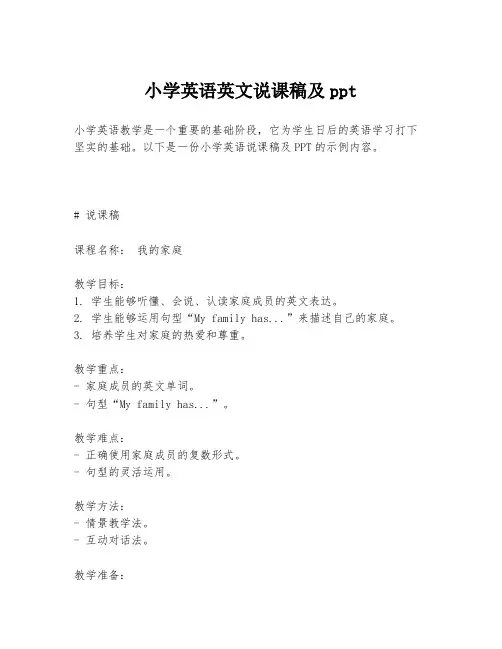
小学英语英文说课稿及ppt小学英语教学是一个重要的基础阶段,它为学生日后的英语学习打下坚实的基础。
以下是一份小学英语说课稿及PPT的示例内容。
# 说课稿课程名称:我的家庭教学目标:1. 学生能够听懂、会说、认读家庭成员的英文表达。
2. 学生能够运用句型“My family has...”来描述自己的家庭。
3. 培养学生对家庭的热爱和尊重。
教学重点:- 家庭成员的英文单词。
- 句型“My family has...”。
教学难点:- 正确使用家庭成员的复数形式。
- 句型的灵活运用。
教学方法:- 情景教学法。
- 互动对话法。
教学准备:- PPT课件。
- 家庭成员的图片。
- 录音设备。
教学过程:1. 导入新课:通过播放一首关于家庭的英文歌曲,激发学生对家庭话题的兴趣。
2. 新课呈现:- 展示家庭成员的图片,教授相应的英文单词。
- 通过PPT展示句型“My family has...”,并让学生跟读。
3. 操练:- 分组让学生用所学句型描述自己的家庭。
- 角色扮演:学生扮演家庭成员,进行对话练习。
4. 巩固练习:- 完成PPT中的填空题,加深对家庭成员单词的记忆。
- 进行小组竞赛,看哪个小组能更快更准确地使用句型“My family has...”。
5. 课堂小结:总结家庭成员的英文表达和句型的使用,强调家庭的重要性。
6. 布置作业:让学生回家与家人一起制作一个家庭树,并用英文标注家庭成员。
教学反思:- 反思学生在课堂上的参与度和学习效果。
- 思考如何改进教学方法,使课堂更加生动有趣。
# PPT内容概要1. 封面页:课程名称、教师姓名、学校名称。
2. 导入页:家庭主题的英文歌曲视频。
3. 新课呈现页:- 家庭成员图片及英文单词。
- 句型“My family has...”的示例。
4. 操练页:- 分组讨论的指导。
- 角色扮演的脚本。
5. 巩固练习页:- 填空题示例。
- 小组竞赛的规则说明。
6. 课堂小结页:家庭成员单词和句型的总结。
英语说课09英本5班刘婷婷ContentsAnalysis of Teaching MaterialTeaching Learning Methods Teaching ProceduresDesign of the blackboard4123Part 1 Analysis of Teaching MaterialStatus and FunctionThe article comes from Unit 1 section A 1a-2c ballbook. This is an important lesson. From this lesson, itstarts asking the Ss to grasp contents of eachSample. To attain “four skills” request of listening,speaking, reading and writing. To start listing “WordBank” and tell the Ss to remember the new words. Tostart asking the Ss to write the English sentenceswell. Therefore this lesson is in the important positionof the teaching material. Such a topic is related todaily life, so it is helpful to raise learning interests ofstudents and it will be also helpful to improve theirspoken English.(1)To enable the Ssto understandand speak: whatis your name?My name is Gina,Make sure thatSs can usethese sentencesin real situations.(2) To help Ss tofinish the wholedialogue. (1)To develop Ss’abilities oflistening andspeaking.(2)To train the Ss’ability of workingin groups.(3) To foster Ss’abilities ofcommunication .1)To foster Ss’consciousnessof good co-operation andpropercompetition.(2)To enable Ss toact naturally .(1)To help Ss learnhow to greetand askothers’names.(2)To enable Ss tostudy in groupsand co-operateskillfully.(3) To develop Ss’interest inEnglish.➢Aims on the knowledge ➢Aims on the abilities➢Aims on theemotion➢Key-points of thislesson◆Teaching aimsDescription of teaching aims❖Teaching methodsAs we all know: the main instructional aims of learningEnglish is to cultivate pupils’ basic abilities of listening and speaking and their good sense of the English language. So in this lesson I’ll mainly use “Task-based” teaching method.That is to say, I will let the Ss learn in real situations, finish a task by making a survey to help the Ss to get a betterunderstanding of the key structure of the dialogue. I willarrange four kinds of activities: singing, guessing game,finishing a survey and having a competition. And in thislesson a recorder, CAI, school things and a printed form will be needed. Students should prepare some school things.❖Learning methods①Teach the Ss how to be successful language learners.②Get the Ss to form good learning habits.③Teach the Ss how to communicate with others and takecompetition methods to develop the Ss interest in English.Warm-up andreviewPresentationHomeworkPractice and ProductionStep1Step2Step4Step3Part 3 Teaching ProceduresStep 1 Warm up and reviewWarm upfour two three four,hands on knees▪one two three four ,clap your hands ▪two two three four,stomp your feet ▪three two three four,nod your head❖Purpose:❖It is important toform a better English learning surrounding for the Ss by singing and doing some total physical response and at the same time it providessituations to review learned knowledgefor the next step.Step 2 PresentationS4Answer S3’s questions ,ask anyone in the classthe questions .S1Greeting with S2,and introduce himself and ask his name. For example :hi, my name is…what is your name ?S3Answer S2’s questions,introduce S2’s conditions and ask S4 the same questions.S2Answer S1 questions and ask S3 what is S1’s name and introduce herselfPurpose of this step❖Play the game to present the key structures one by one is much easier for the Ss to learn and grasp the meanings. Proper competition can arouse the Ss’interest in English learning❖The game can provide a real situation for the Ss to understand the dialogue and the relationshipsbetween people better. Tell the Ss we should show our loveliness to the SsStep 3 Practice and production Divide Students to 4 groups ,practice together in groupsand finally choose the best group ,give the prize.G1G2G3G4Purpose of practice and production❖Task-based teaching method is used here to develop Ss’ ability of communication and also their ability of co-operation will be well trained.❖To check the knowledge Ss have learned in this period.Step4 HomeworkRevision is so important that Ss should speak English as much as they as in class or after class. It is necessary for the Ss to do some extensive exercises after class to consolidate the knowledge they learned.Blackboard design❖New words: what, is , your ,name ,my, etc.❖The phrase: what’s your name?My name is …9英本5班刘婷婷Thank you for your appreciation !!。
小学英语说课稿英文版PPTCertainly! Below is a sample content for a PowerPoint presentation on "Elementary English Lesson Plan" in English.Slide 1: Title Slide- - Subtitle: Engaging Young Minds with Fun and Interactive Learning- Teacher's Name- School Name- DateSlide 2: Introduction- Objective: To introduce the lesson's goals and objectives. - Importance of English in the modern world.- Brief overview of the lesson's content.Slide 3: Learning Objectives- Understand basic English greetings and responses.- Learn to count from 1 to 10 in English.- Recognize and pronounce common colors.Slide 4: Vocabulary- List of vocabulary words to be taught.- Visual aids for each word (e.g., pictures of fruits, animals).Slide 5: Warm-up Activity- Icebreaker game to get students comfortable with speaking English.- Example: "Two Truths and a Lie" about themselves.Slide 6: Greetings and Responses- Common greetings and responses in English.- Role-play scenarios for students to practice.Slide 7: Numbers 1-10- Visual representation of numbers.- Chant or song to help memorize the numbers.Slide 8: Colors- Introduction to primary and secondary colors.- Color identification game with flashcards.Slide 9: Reading Comprehension- Short story or poem for reading practice.- Questions to check understanding.Slide 10: Grammar Focus- Simple present tense for regular verbs.- Examples and practice sentences.Slide 11: Listening Activity- Audio clip of a short story or dialogue.- Listening comprehension questions.Slide 12: Speaking Practice- Group discussions or debates on a given topic.- Encouraging students to use the new vocabulary.Slide 13: Writing Activity- Guided writing exercise to practice forming sentences. - Peer review for constructive feedback.Slide 14: Assessment- Methods to assess student understanding.- Quizzes, oral tests, or creative projects.Slide 15: Differentiation- Strategies for different learning paces and styles.- Group work, individual tasks, or technology integration.Slide 16: Closure- Summary of the lesson's key points.- Reflection on what was learned and how it can be applied.Slide 17: Homework Assignment- Homework tasks to reinforce the lesson's content.- Reading, writing, or interactive online activities.Slide 18: Conclusion and Next Steps- What to expect in the next lesson.- Encouragement for students to continue practicing English.Slide 19: Contact Information- Teacher's contact details for questions or concerns.Slide 20: Thank You Slide- Express gratitude for the students' attention and participation.This PPT layout provides a comprehensive structure for an elementary English lesson, covering various aspects from introduction to conclusion, ensuring a well-rounded and engaging learning experience for young students.。